70 years ago, Springfield was put on the map as home of the 'Great Cobra Scare'
There aren't too many folks left who remember the time when garden hoes were the weapon of choice in Springfield and mothers feared to let children play in the backyard because of what might be lurking in the grass.
Glen Stockton, now 77, was about six years old the summer of 1953, when cobras were found slithering around a Springfield block. In an oral history interview with Missouri State University, Stockton recalled the Springfield Police Department using tear gas to remove a cobra that had snuck under the foundation of his family's home.
The monocled cobra, native to southeast Asia, was eventually retrieved from under the Stockton household. It was just one of 11 serpents that "terrorized" Springfield between Aug. 15 and Oct. 25, 1953.
Tuesday marks the 70th anniversary of what has been deemed the beginning of the "Great Cobra Scare," when Springfield resident Roland Parrish spotted the first cobra in his yard at 1420 E. Olive St.
Seven decades later, the events that occurred in 1953 continue to inspire local projects like Mother's Brewing Company's Cobra Scare wheat ale and musical productions like Central High School's "Kelly the Destroyer Versus the Springfield Cobras," which graced the stage in 2019.
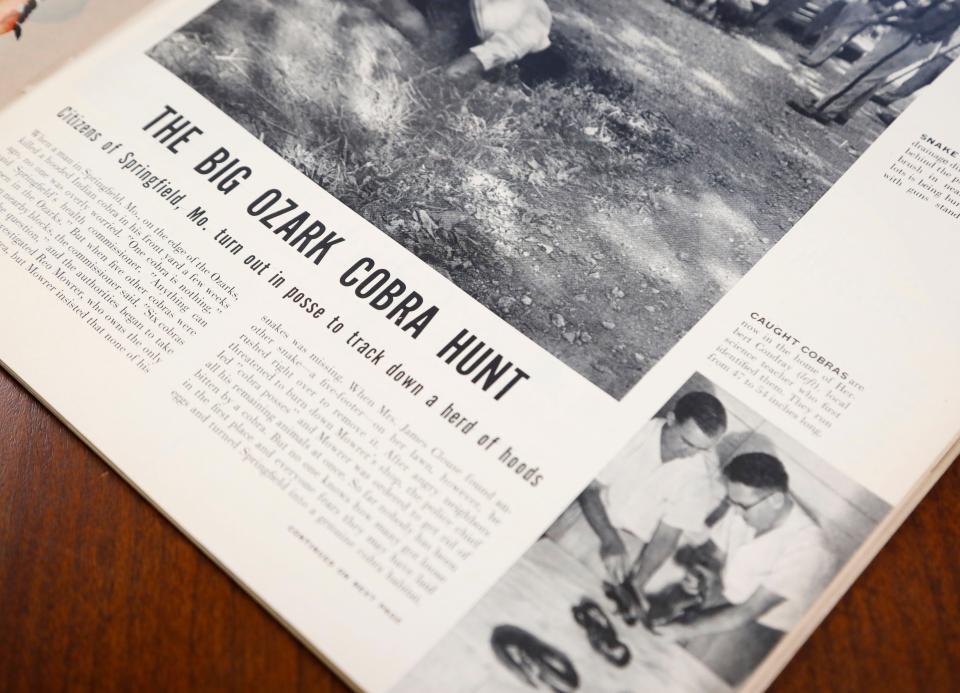
The Scare has gained national attention through the years, with Life Magazine printing two pages about "The Big Ozark Cobra Hunt" in September 1953 and the Travel Channel's "Mysteries at the Museum" airing an episode about the History Museum on the Square's artifacts from the hunt in 2016.
A recap of events from the summer of 1953
When Parrish killed the first cobra on the evening of Aug. 15, 1953, few thought much of it. But when another was discovered one week later in the yard of Wesley Rose at 1421 E. Olive St., the police got involved.
Springfield Police Department officers Raymond Sanders and Gabe Newman answered a call from Rose, whose bulldog Sally had found the four-and-a-half-foot cobra in some shrubbery. After killing the snake, the officers took the carcass to police headquarters, where former Dickerson Park Zoo director Bill Swinea, Drury College science instructor J. M. Parson and Jarrett Junior High School science teacher Herbert Condray identified the snake as a hooded cobra, native to India.
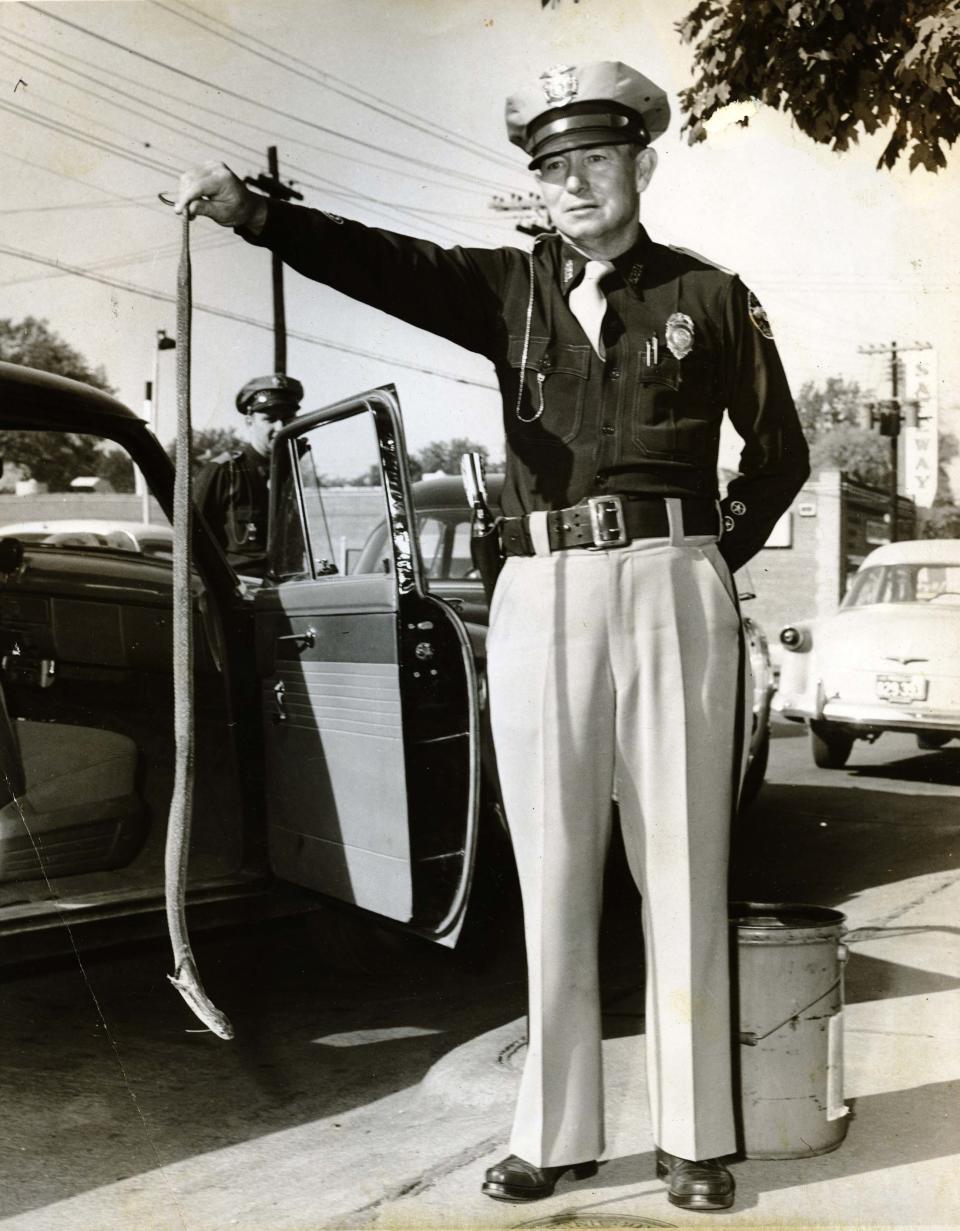
For years, the snakes were erroneously identified as spectacled cobras, which bear two dots connected by a "U" shape on the hood. The snakes, in fact, were monocled cobras, which have a single circular pattern on the hood.
From this point forward, folks began to assume that the cobras came from Mowrer Animal Company at 1421 St. Louis St. Reo Mowrer owned the shop, which was known for selling exotic animals including water moccasins, finches and even an orangutan. The shop was also in the same block where all 11 cobras were found over the three-month span.
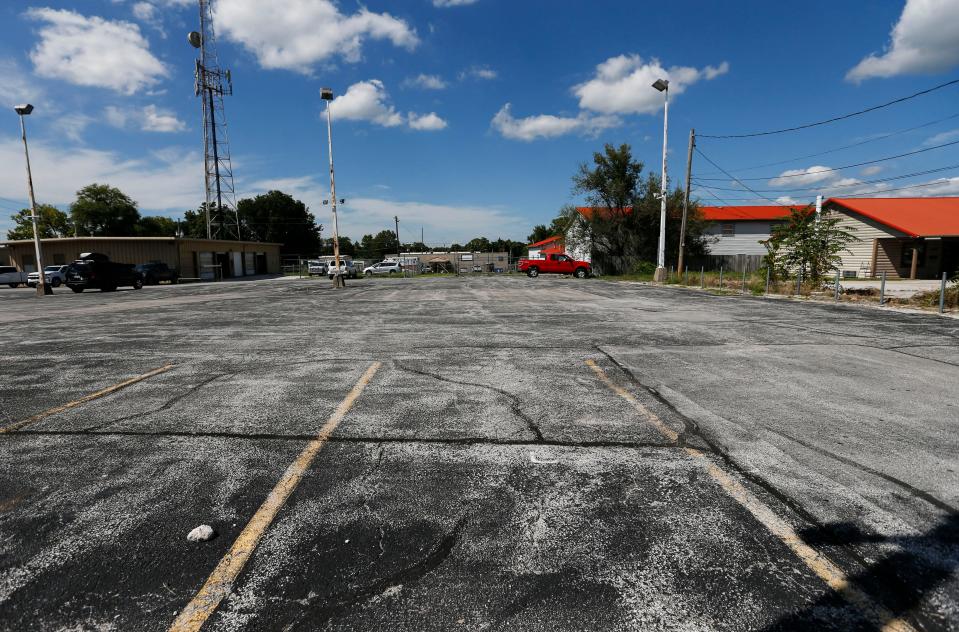
"We haven't had a cobra loose in months," Mowrer told the newspaper in August 1953. "We have them on hand all the time, but we haven't had any get away."
Despite Mowrer's denial of involvement, residents were upset — some even sent death threats. The city began to take action, with the police department launching an investigation of the shop for more potential cobras. Before the investigation took place, Mowrer moved his entire supply of snakes to an "undisclosed location" outside of city limits, according to a Springfield Leader and Press story published in August 1953.
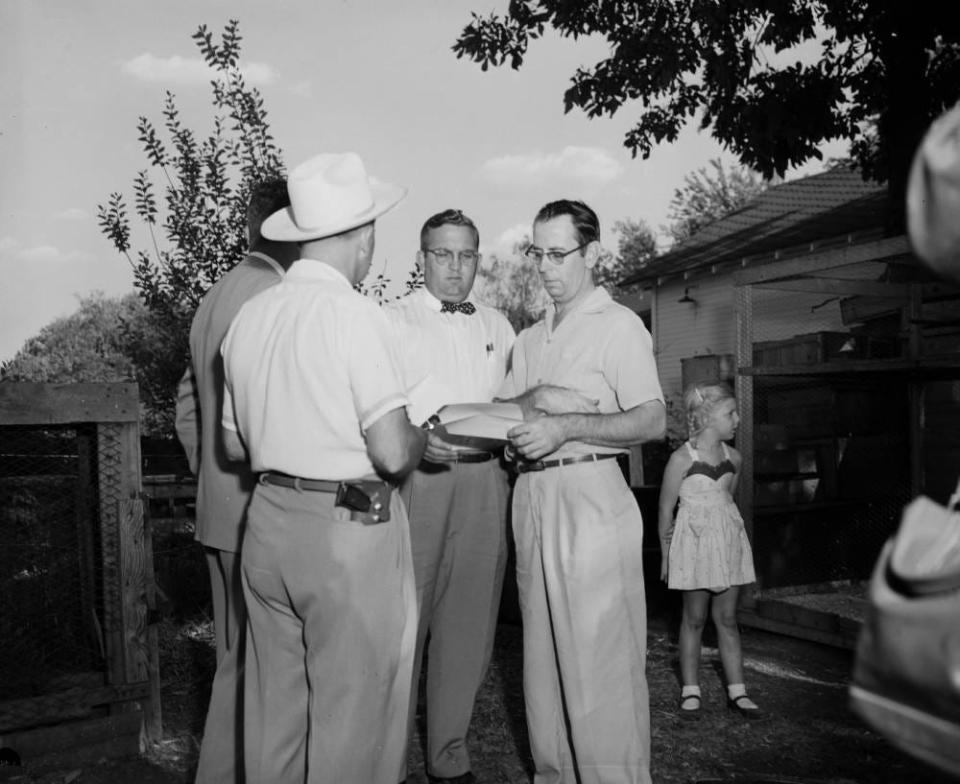
Eight days after the cobra was found in Rose's yard, Ralph Moore found one in his yard at 1410 E. Trafficway St., which was killed with a hoe. That night, 17-year-old Willis Murdaugh spotted a cobra in the road on East Trafficway Street and killed it promptly with a jack handle, running over it several times to make sure the job was done right.
As summer crept on, so did the cobras. On Sept. 3, six-year-old Lisbeth Gail Parrish warned her mother, Mrs. Howard McCoy, that she had watched a snake sneak into the family's garage at 1420 E. Olive St. Wielding a garden hoe, McCoy killed the snake that had coiled itself into a corner.
The same morning, the former Handley City Hospital received a supply of "anti-venom serum" as an antidote from Florida, in case any residents were to be bitten by a cobra. According to a Springfield Leader and Press story published in September 1953, the serum would be offered to any patient, 24/7, for free. Fortunately, the serum never had to be utilized.
A few days later, on Sept 9, some neighbors who lived near Mowrer Animal Company noticed a cobra in the weeds near the shop. Mowrer caught the snake and took it inside before police arrived.
Police utilized tear gas to evacuate cobra
That evening, another cobra was spotted in the yard of L. H. Stockton at 1420 St. Louis St.
In his oral history interview with Missouri State University Dean of Libraries Tom Peters, Glen Stockton recalled that his mother was the first to spot the snake in the family's yard.
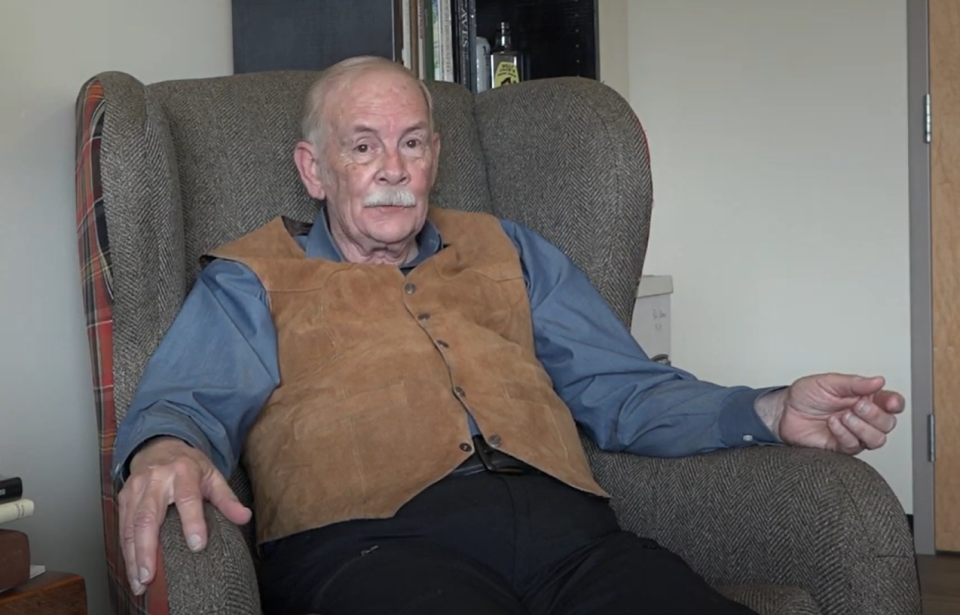
“She babbled and she was panicking," Stockton told Peters about his mother. "We thought something was wrong with her, so we ran for it.
“As we can up toward the garden, something was coming through the grass, which was about six inches high. And it was coming right for us, so I put my sister behind me and said, ‘Don’t move and don’t say anything, be real quiet.’ And then all of a sudden, a snake reared up right in front of me, about four feet away, and its hood spread, and it started weaving back and forth, black beady eyes looking at me with his tongue flicking in and out."
Coming from the family home's back door, Glen's father, L. H., had a rock in his hand and threw it at the cobra.
Although stunned by the attack, the snake was not dead and crawled under the Stockton's house foundation. L. H. Stockton called the Springfield Police Department as reinforcement and instructed his children to go over to the neighbor's house for safety.
Watching from the neighbor's window, Stockton watched as former Police Chief Frank Pike stuck his hand in the hole of the house's foundation and pulled out a long snake skin. Pike decided to take the skin back to the police department for inspection and returned with several other officers.
“They had guns, shotgun was one, and they had flashlights, they had poles," Stockton said. "I think they had a couple of hoes. They had trampled my garden down looking for that snake.”

After some time and no sign of the snake, a "triple-chaser gas grenade" was set off under the house and the snake finally emerged. One of the officers used a revolver, shooting the snake times, with five of the bullets hitting its body. Pike then was able to loop a pole-mounted rope around the head of the cobra, which was killed with a trusty hoe.
After much contention with city officials and the police, Mowrer was ordered to move the remainder of his shop outside of the city a few days after the gas grenade was set off. But even after Mowrer left, cobras continued to appear. On Sept. 16, H. K. Patton ran over a cobra on East Chestnut Expressway, which he then killed with a large rock.
For a few weeks, no more cobras were discovered; folks thought perhaps the coast was clear. But on Oct. 1, an eighth cobra was found by Dan Funkhouser at Springfield Plumbing and Heating Company at 1221 St. Louis St. With the help of employee Hardy Teague, the two thought they killed the cobra and placed the body in a lard can before taking it to police headquarters. When Lt. Leonard Thomas opened the lard can, the cobra moved its tail and opened its jaws at him. He killed the injured cobra with an ice pick.
'Cobra Blues'
With community confusion and fear continuing to grow, former Health Director Del Caywood decided to try something different. Obtaining a sound truck, Caywood cruised the streets of Springfield playing "snake charming" music over the loud speakers in the hope of luring more cobras out. The music was referred to as the "Cobra Blues."
“John Dukewits, a local car dealer, brought me a phonograph record that a relative of his had obtained in India," Caywood told the News-Leader in 2003. "The music on that record was said to have an effect on cobras. John told me, ‘Try it — maybe it’ll work.’ I said: ‘Why not? Nothing else seems to be working.’”
Many were skeptical of this effort, including Mowrer, who claimed that the sound truck would be a good publicity stunt but would not attract any cobras.
“I wouldn’t be caught dead there," Mowrer told the News-Leader in October 1953. "People in the reptile world recognize that I have a little bit of intelligence.”
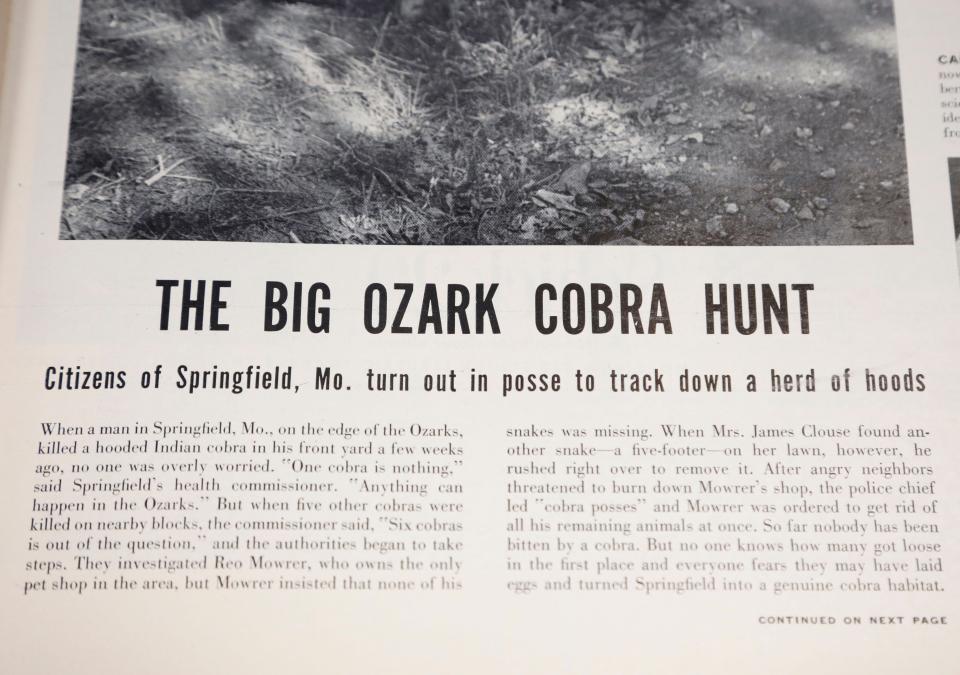
But after about 45 minutes of the truck driving around, a cobra was spotted and killed.
This, however, was a complete coincidence, Kevin Jansen, Lora Bond Chair of Biology at Drury University, told the News-Leader in July. Snake charming is based entirely on movement, not sound. Cobras mimic the movement of charmers who sway back and forth.

Jansen also debunked the myth — discussed by residents in 1953 — that snakes cannot hear. Snakes do hear, just at a lower decibel range than humans. Snakes, for the most part, rely on sound vibrations close to them.
The final, eleventh cobra, was spotted Oct. 25 in the 1400 block of East Olive Street. The snake was taken — alive — to the Dickerson Park Zoo to put on display. It died two months later.
Who was behind the release of the cobras?
For 35 years, the Springfield community remained uncertain about how 11 cobras were displaced in the city. On June 26, 1988, the News-Leader published a story that answered the decades-long, "Who done it?"
Carl Barnett, around 60 years old in 1988, stepped forward to share his story of letting the cobras loose when he was 14 with longtime News-Leader journalist Mike O'Brien.
“Barnett nevertheless is wary about sharing his story," O'Brien wrote, opening the story. "He agreed to discuss the incident with a News-Leader reporter only after a pal convinced him that the community is owed an explanation — and only after an attorney assured that criminal charges are unlikely to be filed 35 years after the fact."
A regular customer of Mowrer's in the early 1950s, Barnett and the shop owner worked together through a trading system. Barnett and his friends would bring snakes they found around town to the shop and Mowrer would trade them for fish. It was one bad trade that led to the release of the cobras. After bringing in some snakes to the shop, Barnett chose a tropical fish to take home. Unfortunately, the fish died that night, which upset Barnett.
He visited the shop the next day to chat with Mowrer but the owner was not in. Instead, a "disgruntled" employee stood behind the counter, unwilling to help out the teenage customer. After leaving the shop, Barnett decided to walk around back to see if Mowrer had any new animals around and came across a large, wooden create.
“I thought to myself, ‘Well, these aren’t the same snakes I traded for the fish, but they’re probably about equal value. So maybe I’ll just leave the door open, and then we’ll be even,' Barnett told the News-Leader. "And that’s just what I did — just left the trap door open and got on my bike and rode home. I started hearing that cobras were turning up in people’s yards near Mowrer’s shop. I realized what I’d done, and I was scared to death. Every time someone mentioned the cobras, I just wilted. And as more and more of (them) turned up, they got mentioned plenty.”
Recalling the events 35 years later, Barnett estimated that the crate he opened had 25 to 30 snakes inside, which he did not recognize as cobras when he initially looked in.
“I didn’t do it to harm no one," Barnett told the News-Leader. "I was only trying to get even after I thought I’d been (cheated) on a tropical fish deal. I didn’t know what kind of snakes they were, or I never would have let them go.”
One cobra carcass remains
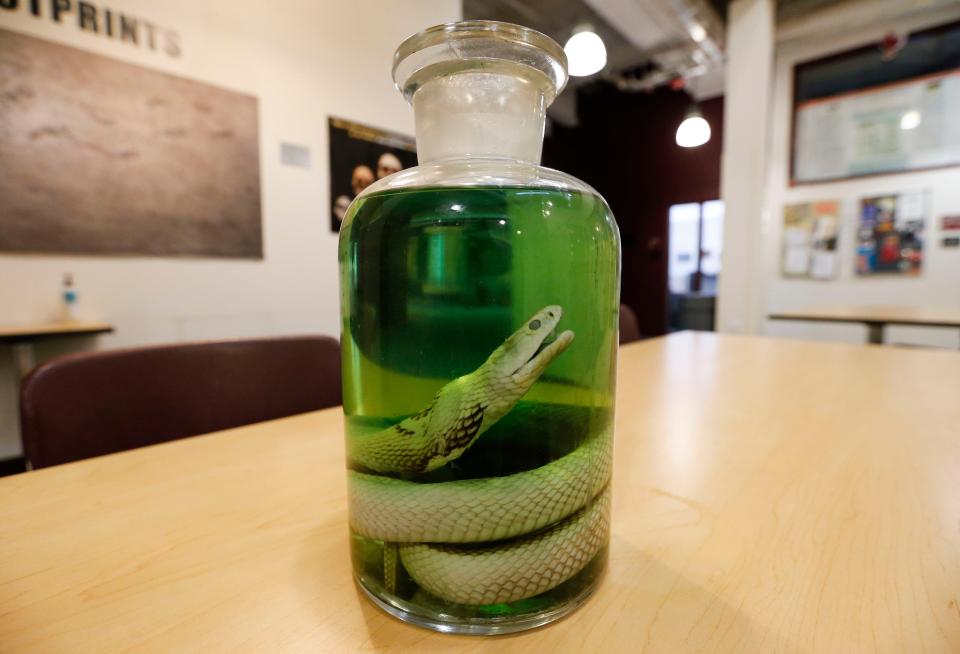
It is believed that Condray, the science teacher at Jarrett Junior High School, preserved at least six of the cobras, but 70 years later, only one cobra carcass — as far as we know — remains intact. Inside a glass jar of isopropanol, the reptilian cadaver is kept safe inside a climate-controlled room at the Drury University Natural History Museum.
Barring a bullet-hole wound just below its hood, the cobra could possibly have been the one that was evacuated from under the Stockton household with a gas grenade, but Jansen said the university is unsure which numbered cobra it actually is.
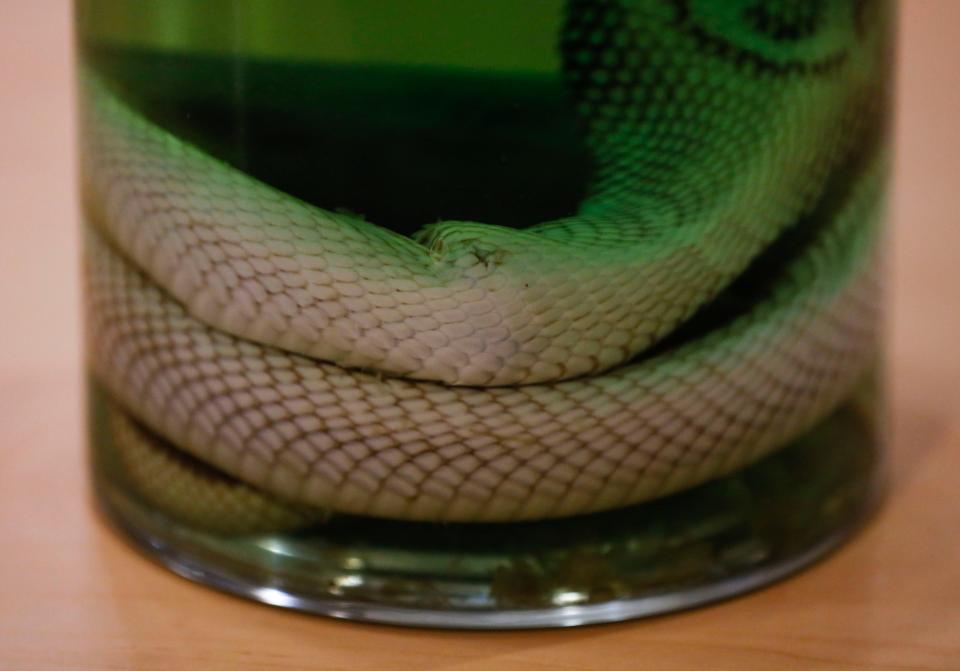
The cobra was donated to the university in 1980 by former Greene County Sheriff Mickey Owen and re-preserved by Drury University biology professor Robert Ingersol the same year. Jansen said the cobra's isopropanol is replaced every three to five years to keep fresh.
And so the story of Springfield's Great Cobra Scare is preserved.
Note: In addition to recent interviews, this story drew on interviews and research from previous News-Leader coverage.
Greta Cross is the trending topics reporter for the Springfield News-Leader. Follow her on Twitter and Instagram @gretacrossphoto. Story idea? Email her at gcross@gannett.com.
This article originally appeared on Springfield News-Leader: Remembering the 'Great Cobra Scare,' 70 years later
